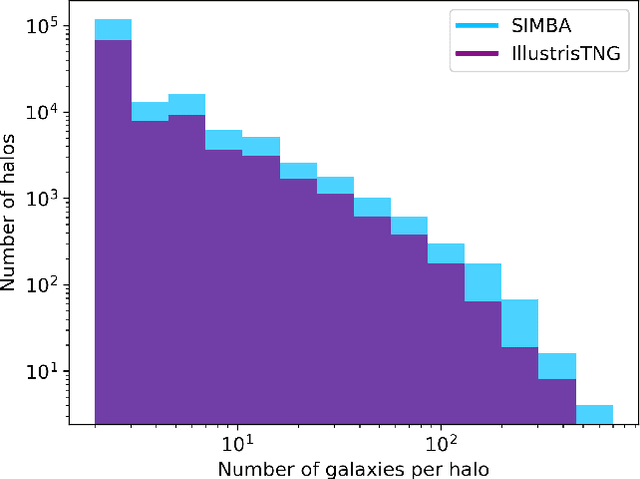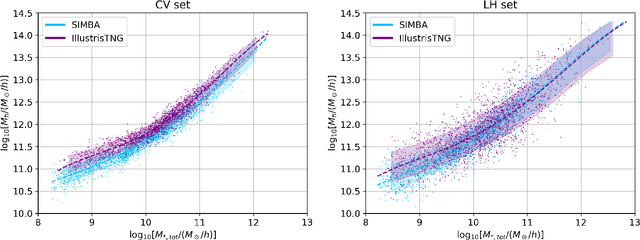Federico Marinacci
Field-level simulation-based inference with galaxy catalogs: the impact of systematic effects
Oct 23, 2023Abstract:It has been recently shown that a powerful way to constrain cosmological parameters from galaxy redshift surveys is to train graph neural networks to perform field-level likelihood-free inference without imposing cuts on scale. In particular, de Santi et al. (2023) developed models that could accurately infer the value of $\Omega_{\rm m}$ from catalogs that only contain the positions and radial velocities of galaxies that are robust to uncertainties in astrophysics and subgrid models. However, observations are affected by many effects, including 1) masking, 2) uncertainties in peculiar velocities and radial distances, and 3) different galaxy selections. Moreover, observations only allow us to measure redshift, intertwining galaxies' radial positions and velocities. In this paper we train and test our models on galaxy catalogs, created from thousands of state-of-the-art hydrodynamic simulations run with different codes from the CAMELS project, that incorporate these observational effects. We find that, although the presence of these effects degrades the precision and accuracy of the models, and increases the fraction of catalogs where the model breaks down, the fraction of galaxy catalogs where the model performs well is over 90 %, demonstrating the potential of these models to constrain cosmological parameters even when applied to real data.
Weighing the Milky Way and Andromeda with Artificial Intelligence
Nov 29, 2021



Abstract:We present new constraints on the masses of the halos hosting the Milky Way and Andromeda galaxies derived using graph neural networks. Our models, trained on thousands of state-of-the-art hydrodynamic simulations of the CAMELS project, only make use of the positions, velocities and stellar masses of the galaxies belonging to the halos, and are able to perform likelihood-free inference on halo masses while accounting for both cosmological and astrophysical uncertainties. Our constraints are in agreement with estimates from other traditional methods.
Inferring halo masses with Graph Neural Networks
Nov 16, 2021



Abstract:Understanding the halo-galaxy connection is fundamental in order to improve our knowledge on the nature and properties of dark matter. In this work we build a model that infers the mass of a halo given the positions, velocities, stellar masses, and radii of the galaxies it hosts. In order to capture information from correlations among galaxy properties and their phase-space, we use Graph Neural Networks (GNNs), that are designed to work with irregular and sparse data. We train our models on galaxies from more than 2,000 state-of-the-art simulations from the Cosmology and Astrophysics with MachinE Learning Simulations (CAMELS) project. Our model, that accounts for cosmological and astrophysical uncertainties, is able to constrain the masses of the halos with a $\sim$0.2 dex accuracy. Furthermore, a GNN trained on a suite of simulations is able to preserve part of its accuracy when tested on simulations run with a different code that utilizes a distinct subgrid physics model, showing the robustness of our method. The PyTorch Geometric implementation of the GNN is publicly available on Github at https://github.com/PabloVD/HaloGraphNet
 Add to Chrome
Add to Chrome Add to Firefox
Add to Firefox Add to Edge
Add to Edge